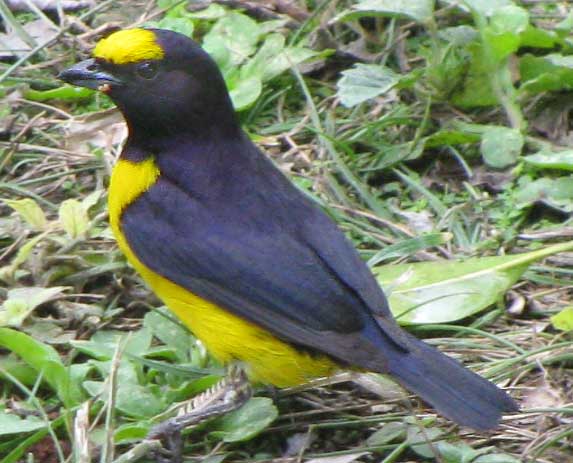Excerpts from Jim Conrad's
Naturalist Newsletter

from the March 14, 2010 Newsletter issued from Hacienda Chichen Resort beside Chichén Itzá Ruins, central Yucatán, MÉXICO
SCRUB EUPHONIA
A Scrub Euphonia, EUPHONIA AFFINIS, is shown on the hacienda's grassy lawn above. Maybe the main reason he'd come onto the grounds is that now our dry season is really starting to crunch, day after day things getting drier, crisper, dustier and hotter. The bird in the picture seemed very hesitant to leave his spot, which was beside a curled-up leaf on the lawn where the sprinklers were going, for the curled-up leaf cupped a few drops of water. I also guess that the bird had just flown from inside the nearby strangler fig tree now heavy with ripe, spherical, marble-size figs of the color of the matter sticking to the euphonia's lower mandible.
Based on the bird's black and yellow colors, and the thick beak, northerners might think that euphonias, of which the Yucatán hosts two similar species, must be closely related to goldfinches. However, euphonias and goldfinches belong to different subfamilies. Euphonias belong to the Tanager Subfamily, the Thraupinae. Howell describes them as "small stubby tanagers."
Scrub Euphonias are fairly common in disturbed areas from Mexico to northwestern Costa Rica.
from the July 13, 2018 Newsletter issued from Rancho Regenesis in the woods ±4kms west of Ek Balam Ruins; elevation ~40m (~130 ft), N~20.876°, W~88.170°; central Yucatán, MÉXICO
YOUNG, CURIOUS SCRUB EUPHONIAS
Here in the early rainy season with plenty of bugs hatching and new herbage sprouting, it's common to see young birds not long from their nests out exploring their new worlds. This week I was lucky to photograph what seemed to be adolescent siblings eyeing every detail of an Aechmea bromeliad perched midway up a Huano Palm's trunk, shown below:

Steve Howell in his A Guide to the Birds of Mexico and Northern Central America describes Scrub Euphonia young as looking like adult females, which display a grayish head with yellow-olive forehead, except that young birds have olive heads. In our bromeliad group the bird at the left must be a young female. Howell also says that young males quickly attain the plumage of adult males, so the two birds at the right must be young males displaying their early attained adult plumage.
It's not surprising that young euphonias would be curious about a big bromeliad's details. Euphonias often nest among bromeliads, and I bet they'll feed on the Achmea's fruits when they're ripe. You might enjoying taking a closer look at Achmea bromeliads at www.backyardnature.net/yucatan/aechmea.htm
from the April 24, 2011 Newsletter issued from Hacienda Chichen Resort beside Chichén Itzá Ruins, central Yucatán, MÉXICO
A SCRUB EUPHONIA'S NEST
This week, next to Old San Isidro Church, a male and female Scrub Euphonia were fussing around a certain bromeliad-covered branch of a big Cedro tree, It turned out the church pair were building a nest between two bromeliad tufts beneath a big limb, shown below:

When the wind blew, the bromeliads as well as the nest shuddered and whipped back and forth. It seemed a precarious place for a nest, but I suspect it'll hang there for a long time.
That's a classic globular nest, like the one we saw last July occupied by mouth-gaping Yellow-throated Euphonia nestlings, Yellow-throateds being our other euphonia species. You can see that nest with nestlings at www.backyardnature.net/yucatan/euphonia.htm .
In A Guide to the Birds of Mexico and Northern Central America Howell describes nests for the genus Euphonia, of which five species exist in Mexico, as "globular structures with a side entrance... in hanging masses of vegetation, bromeliads, tree crevices, even on mossy banks." Therefore, our nest in the picture is a pretty typical euphonia nest.